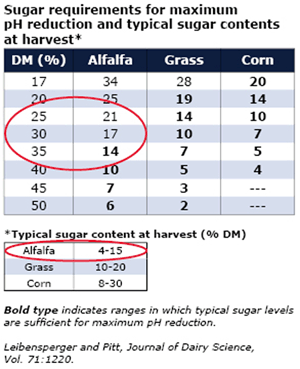
Battling clostridial bacteria with wet forages (Chris Wacek-Driver)
 Chris Wacek-Driver, Vita Plus forage program manager
Chris Wacek-Driver, Vita Plus forage program managerAlfalfa is a particularly challenging crop to ensile due to naturally occurring compounds (primarily acids and proteins) that effectively buffer the crop. Practically speaking, this means it takes more acid – and thus more sugar – to reach the correct pH endpoint. At moistures of 65 percent or greater, 12 to 15 percent of the dry matter (DM) needs to be converted to acid to reach a final pH. This combination of high pH and high moisture creates the ideal environment for clostridial and other detrimental organisms to flourish.
The challenge of clostridial bacteria
Clostridial bacteria are undesirable since they produce the dreaded butyric acid fermentations that create animal health issues and loss of forage DM and energy. Clostridial bacteria occur naturally in manure and soil and their spores are a contaminant in varying amounts on harvested forage.
While we define the problem with alfalfa turning clostridial or having high butyric acid content as a moisture problem, the real issue is low sugar levels. Simply put, above 65 percent moisture, bacteria do not have adequate sugar available to produce enough acid even in ideal situations. (See table below.) Typical sugar content of alfalfa at harvest varies from 4 to 15 percent of the DM. If we look at the sugar required to ferment forages at 35 percent DM or lower, we can see the sugar requirement for ensiling is not met.
Increased challenges in first crop
In particular, first crop – with its typically heavier yields, poorer spring drying conditions and corresponding weather challenges – often creates less-than-ideal conditions. Additionally, forages which receive rain, lay in the field longer than desired, and simply take longer to harvest and/or seal in the storage unit can result in significant losses and/or leaching of valuable crop sugars. Add in the fact that soil and manure are excellent sources of clostridial contamination and it is sometimes amazing we get the success rates of fermentation we do!
Inoculants and added sugars
So how do we swing the odds in our favor? Inoculating with a fast-growing, up-front inoculant is critical to drop the pH as quickly as possible. Filling quickly, packing well and effective sealing eliminate air immediately and save precious sugars. Some inoculants claim to prevent clostridial production. To date, we have seen no independent, published research in farm-scale silos to substantiate these claims.
Applying any quick-growing inoculant will buy some time prior to a forage going clostridial, particularly if excellent packing and immediate and effective sealing are employed. Reviewing the available research on these “anti-clostridial” inoculants shows they are no better than other fast growing inoculants at preventing butyric acid formation. More importantly, research conducted in lab-scale silos, under ideal situations, are vastly different than our commercial silo structures. Small, lab-scale silos enable quicker filling and sealing techniques and less contamination than possible on the farm. While inoculants buy time, unless clostridial spores are killed in the forage, they will still flourish. In our field experiences, we have observed many of these products that claim “anti-clostridial” properties turn butyric given time.
So what can be done?
Research has shown applying a good sugar source (like liquid whey or molasses) at 1 percent of the forage DM can go a long way in helping the fermentation. Obviously, cost and finding a way to apply it will eliminate its use for a lot of producers.
Managing and feeding wet forages
A common response we sometimes hear with high moisture alfalfa is “well it was only a few loads.” Here’s the problem: If that forage went into a large bunker, pile or upright silo, how do you dig out those loads or layers once they turn clostridial?
Consider this scenario: The forage went up wet despite your best efforts, but you packed it well and sealed it immediately.
Give the crop a couple weeks to ferment and start feeding it immediately. Since clostridial organisms like high pH levels and will utilize the lactic acid over time, letting these forages sit only makes the situation worse.
Many times, under good management situations, we may have a couple months before the forage goes clostridial. In fact, a management practice we have employed is to separate those wet, less-than-ideal loads into a separate pile, seal them immediately (the same day if at all possible), and feed them after a two-week fermentation.
Once the forage begins to go clostridial, keep the it out of dry, transition and fresh rations. For other rations, laying out the forage in thin layers will dissipate some of the acids and cows will often adjust intakes. Keep in mind it will not prevent some of the health and/or reproduction problems often reported with these silages if fed in any amount.
Lastly, if you have done the best job you could with what you had available at the time, don’t beat up yourself or others if you see less-than-stellar fermentations coming out of storage. Even commercial beer and wine fermentations fail under much more controlled conditions.

| Category: |
Feed quality and nutrition Forage Foundations Forage inoculants Forage storage and management |

